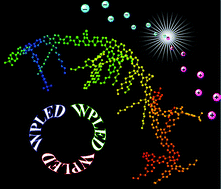Recent design tactics for high performance white polymer light-emitting diodes
Abstract
White polymer light-emitting diodes (WPLEDs) represent an intense research subject towards their potential applications in full-color displays, next-generation solid-state lighting sources and back-lighting of liquid-crystal displays due to their merits including low-cost fabrication, flexibility, large area and ease of construction etc. Unfortunately, WPLEDs generally show much poorer EL performance with respect to those made by the vacuum deposition strategy owing to the inherent disadvantages associated with the materials used, device structures and device fabrication processes etc., which has seriously restricted their practical applications. However, the performances of WPLEDs have been improved greatly in recent years, and can even realize some practical devices. In this review, the critical design tactics employed to achieve this goal are presented, which include developing high performance functional light emitters, maintaining a good charge injection/transport balance, introducing new functional layer, surface morphology engineering and employing novel device construction processes etc. In addition, the ongoing challenges and future perspectives of this research frontier are also highlighted.


 Please wait while we load your content...
Please wait while we load your content...